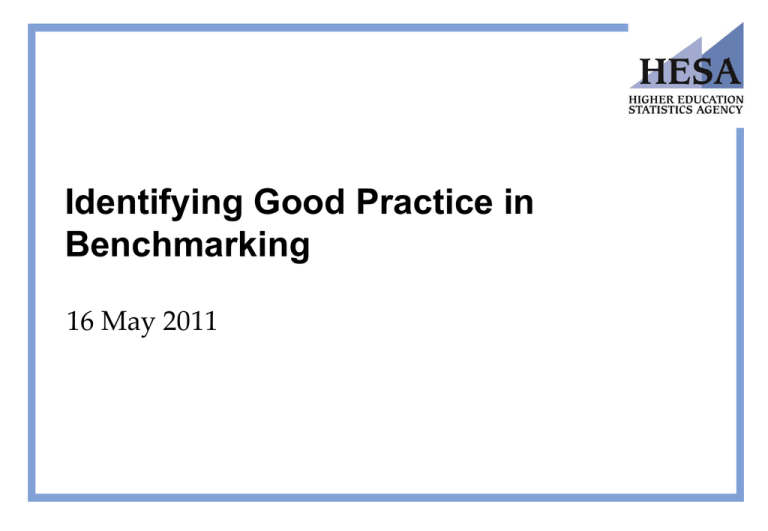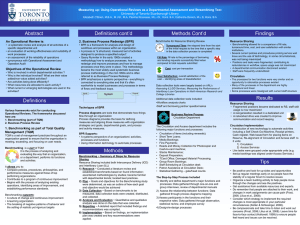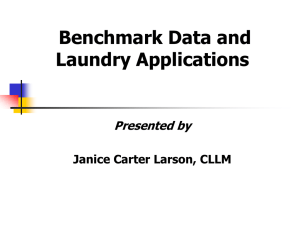Identifying Good Practice in Benchmarking
advertisement

Identifying Good Practice in Benchmarking 16 May 2011 Aims of the day • To update you on the HESA benchmarking project and associated activities • To present some benchmarking case studies/perspectives for discussion • To invite you to discuss a range of issues around good practice in benchmarking, to hear your perspectives and exchange ideas • To generate material that will feed in to new benchmarking resources for the sector Agenda 10.15-10.30 10.30-10.45 10.45-11.10 11.10-11.30 11.30-11.50 11.50-12.10 12.10-12.30 12.30-1.00 1.00-2.20 2.20-3.00 Arrival and coffee Welcome and introduction, and the HESA Benchmarking Project Jonathan Waller, Director of Information and Analysis HESA Warwick’s approach to BI and Benchmarking Giles Carden, Director of MI and Planning, Warwick University International benchmarking: progress on the HESA-commissioned study Mike Boxall and Andrew Webb, PA Consulting The Brunel approach to Financial Benchmarking John Robinson, Finance Director, Brunel University Future directions for benchmarking Patrick Kennedy, Director of Strategic Planning and Change, and Nicki Horseman, Assistant Director, Strategic Planning, Exeter University Questions and discussion on morning sessions Jonathan Waller and Giles Carden Lunch Discussions: two groups led by Anita Wright, Head of Information and Planning, Liverpool University and Mike Kennerley, Strategy and Performance Manager, Leeds University Plenary report back and summary The project – ‘Realising business benefits through use of benchmarking’ • Phase 1 – HESA commissioned by HEFCE to provide an assimilation of current benchmarking activity within the UK HE sector – First phase ran from 24 June 2010 to publication of final report on 4 November 2010 – Project methodology • Survey of academic and other existing studies on benchmarking • Semi-structured interviews with HEIs, sector associations and other relevant organisations • Online survey of HE planning community Phase 1 findings • ‘Making the case’ for benchmarking • Sharing of knowledge and good practice • Development and sharing of methodologies, tools and frameworks • Weaknesses and access barriers in data • Use of the heidi system to support benchmarking • Learning from the experiences of other sectors • The international dimension • Recommendations Phase 2 • Funded primarily from HEFCE University Modernisation Fund • Project running from November 2010 to April 2012 • Objectives – Promote senior ownership and recognition of the value of benchmarking – Establish business requirements for benchmarking – Engage with cognate activities in the sector – Develop a communication and dissemination plan • Web microsite www.benchmarking.hesa.ac.uk • JISC Infonet • Conferences and seminars – Review techniques and tools in use and ensure these are presented in a way that can be accessed and shared Phase 2 • Objectives – continued – Map relevant information sources (within and beyond the sector) • Cluster around business needs • Seek to unlock less known or accessible sources • Provide indication of quality and utility of information sources – Develop heidi to support benchmarking – Seek ideas and input on benchmarking activities from other sectors (public sector and commercial contexts) – Review and develop the capacity and approach to benchmark internationally Forthcoming project events • Strategic planning – use of evidence and benchmarking 7 June, London (GuildHE and AMHEC institutions) • Process benchmarking 24 June, HESA • International benchmarking 20 July, London Warwick’s Approach to BI & Benchmarking Dr Giles Carden Director, Management Information and Planning University of Warwick Outline Key drivers Benchmarking landscape Technology Early projects Warwick’s design framework Presentational standards Summary: Key elements of success The future Business Drivers – Why use BI & Benchmarking? Automate Academic Statistics Strategic departmental reviews Financial planning, incl. student numbers (Studentrelated income accounts for c.42% of total income) Excellence in research performance reviews of staff Academic resource planning Process measurement & improvement Key Objectives of BI Analysis To inform • Example: HR Performance Management Strategy strategic decision-making Assist in shaping • Example: Vision 2015 drove BI development and now BI translates the future of the data into strategic decisions institution Evolving BI Landscape Complexity Integrated Reporting Publications & Bibliometrics Dashboards Utility reporting HR Reporting Pre-award Dashboards PGR Dashboards Space Dashboards Research Income Dashboards OFFA agreement monitoring RAE Modelling 2006 QR Modelling 2008 HESA Benchmarking 2010 2012 Time 2014 Technology - Organisation of the Data Early Stage Projects Student number planning Academic Statistics online Admissions reporting National Research Assessment Exercise benchmarking Research dashboards Warwick’s Design Framework What areas of activity do you want to better understand? What specific questions do you want to answer? Which data are available to answer your questions? What are the limitations? Are comparable datasets available? How should the data best be presented to answer the key questions succinctly & unambiguously? Who is your audience? Principles for an Effective Presentation Normalise/ standardise data if necessary Keep textual commentary to a minimum Contextualise & Compare Ensure questions that you want answered are clear Effective Presentation Know your audience Effective Presentation – Research Dashboards Effective Visual Presentation Effective Presentation – Research Income per FTE benchmark Effective Presentation – RAE 2008 Benchmark Products – Reports Audience - Senior Management £70 • How are we doing compared to last year/forecast? Value (£m) £60 £50 £40 £30 £20 £10 £0 A S O N D 07/08 F M 08/09 A M J J J J 09/10 Warwick vs Russell Group £6 £4 value (£m) • How are we doing against the competition? J £2 £0 -£2 -£4 -£6 A S O N D J F M A M Audience - Heads of Department • How are individuals performing in my department? Value (£m) • How can performance improvements be correctly targeted? £6 100% £5 80% £4 60% £3 40% £2 20% £1 £0 0% Staff • How is my performance compared against previous years? Count Audience – Individual Academics 16 14 12 10 8 6 4 2 0 02/03 03/04 04/05 05/06 • How is my performance compared against my peers? Value (£m) Application 06/07 07/08 08/09 Award £16 £14 £12 £10 £8 £6 £4 £2 £0 03/04 04/05 Individual 05/06 06/07 07/08 Dept Average 08/09 Key Elements of Success Development and retention of in-house expertise Stakeholder involvement in development Senior staff buy-in Leadership Managing and responding to organisational change Data Security Presentation simplicity and clarity Future Benchmarking Projects INTERNATIONAL HIGHER EDUCATION BENCHMARKING IN THE UK Project Overview Mike Boxall and Andrew Webb 16th May 2011 Agenda/contents Project aim Sources identified so far Information being sought © PA Knowledge Limited 2011. Page 29 Project Aim The Benchmarking to improve efficiency status report, published on November 2010 stated: ‘UK universities are under increasing pressure to show how they perform relative to universities in the global community and there is growing interest in transnational benchmarking to make reliable international comparisons and learn from other HE systems.’ PA are therefore tasked with undertaking the following: Needs assessment – a brief exercise to identify the critical needs and uses of international benchmark information Review of available resources – a desk exercise to identify and assess the available resources for each of the five interpretations of benchmarking, grading them against the requirements and criteria identified through the initial needs analysis. Assessment of gaps and unmet needs – we will apply our judgement and sector knowledge to assess the extent to which the available resources meet the sector’s expressed needs for benchmarking information Proposals for meeting future benchmarking needs – our report from the previous stages of work will summarise the sector’s needs for international benchmarking information, the extent to which these are or could be met from current resources © PA Knowledge Limited 2011. Page 30 Sources identified so far Whole University Ranking – Times Higher Education Ranking – QS World Universities Ranking – Academic Ranking of World Universities (ARWU) – CHE Excellence Rankings – RatER Global University Ranking of World Universities – Webometrics Ranking of World Universities – 2010 World University Ranking – SIR World Report – Leiden Ranking – University Ranking by Academic Performance – The Performance Ranking of Scientific Papers for World Universities – Professional Classification of Higher Education Institutions – International Student Barometer (ISB) © PA Knowledge Limited 2011. Page 31 Sources identified so far (continued) Market Data – OBHE (Observatory on Borderless Higher Education) – UNESCO Institute for Statistics Indicators – OECD Higher Education Statistics – OECD/Institutional Management in Higher Education insights (IMHE) – Global Higher Education Rankings Affordability & Accessibility in Comparative Perspective Institutional process comparisons – Association of Common wealth universities (ACU) Benchmarking Programme Institutional process comparisons – British Council Education Market Intelligence (EMI) – Academic Analytics business intelligence reports © PA Knowledge Limited 2011. Page 32 Information being sought PA are keen to hear views from institutions on: the key metrics and performance measures you use to test the University's internationalisation strategy and operations what areas you seek to benchmark and against which classes of institutions: for example - international ranking tables - research results - staff standing - recruitment - processes and approaches - market intelligence what sources do you use for benchmarking, and how useful do you find them what in-house and bespoke benchmarking methods do you use are there any important unmet benchmarking needs that you would like to see addressed © PA Knowledge Limited 2011. Page 33 Benchmarking John Robinson Director of Finance This is what we are going to do today ... Overview • • • • What is benchmarking? Compare and contrast Financial Applications Limitations Motivation for benchmarking? • To find secrets of business success we need to study successful businesses What is benchmarking? • Sometimes easier to see what it is by saying what it isn’t • Compare and improve different definitions – all in HESA report. What is benchmarking? • “Benchmarking is a valuable tool for HEIs in conducting comparative analyses of institutional and external information in order to identify efficiencies and cost reductions and to target these to best effect” HESA p.3 What is benchmarking? HEFCE Definition • “ A process through which practices are analysed to provide a standard measurement (“benchmark”) of effective performance within an organisation (such as a university). Benchmarks are also used to compare performance with other organisations and other sectors”. What is benchmarking? HEFCE Definition • “ A process through which practices are analysed to provide a standard measurement (“benchmark”) of COST effective performance within an organisation (such as a university). Benchmarks are also used to compare performance with other organisations and other sectors” SO AS TO IMPROVE THE ORGANISATION’S COMPETITIVE PERFROMANCE. What is benchmarking? • “Benchmarking … allows the University to get a sense of where it is performing well in relation to others” HESA p8 What is Benchmarking? • • • • • • Not just - Compare and contrast Not just analysis of similarity and difference But some sort of first cousin to these? To raise questions? To provide answers? Indicative or conclusive? Financial Information barriers (Recommendation 4) • Data is available, public, consistent over time, granular (?), comparable, accurate, timely. • Annual Reports and Accounts in standard format with narrative audited and published. • HEIDI collates this well. • Comparable across sectors and nations HEFCE funding £M 2010-11 by size Rank Current £9k Fee Level Announcements • • • • • • • • • • • • • • Aston University University of Bath University of Birmingham University of Cambridge University of Central Lancashire City University Coventry University (£7,500 - £9,000) Durham University University of Essex University of Exeter Imperial College London Keel University University of Kent Lancaster University SUMMARY OF SURPLUS PEER GROUP AND OTHERS 2009 – 2010 SURPLUS/ ( DEFICIT) FOR THE YEAR 25% 19% 20% 15% 10% 5% 0% 5% 3% 0% -1% 2% -5% -10% -15% -20% -25% -30% -25% KPI Comparisons Surplus as % of Income Sector Mean Net Liquidity (Cash/Costs) 2010 2014 3.4% 1.2% 3.6% 134 Days Sector Mean 98 Days Borrowing as % of Income 57.0% Sector Mean Reserve (excluding pension) as % of Income Sector Mean Net Cash Flow as % of Income Sector Mean Staff Costs as % of Income Sector Mean 76 Days 50.3% 21.1% 98.1% 94.4% 46.1% 11.2% 9.9% 8.2% 53.6% 54.3% 57.4% INCREASING ACADEMIC STAFF IN DIFFICULT TIMES SSR COSTS (ADJ) PER STUDENT SURPLUS % STAFF COSTS % BRUNEL WARWICK QUEEN MARY TVU 20.2 14.1 13.6 14.2 £9.2K £15.0K £14.2K £10.0K 3% 2% 2% -25% 53.6% 50.5% 58.8% 69.5% Comparability at different levels • • • • • • External boundaries defined (off balance sheet?) Internal boundaries discretionary and vary Tribal deal with HEI benchmarking of costs Functional definition of costs– ‘like with like’ “We use their data for budgeting purposes” “We say Finance costs are x% of income so that figure (reversing adjustments) becomes Finance department budget” Limitations? • “Lack of granularity in available data – limited ability to ‘drill-down’ into the data” p.29 • “Most common problem was a desire for greater granularity, depth and flexibility in the data contained within heidi” p.30 • “heidi not being a ‘one-stop shop’ and there being a continued requirement to source other data” p.30 DRILLING DOWN (1) Good Institution (s) Constituents & Organisation Components & Structure Answer DRILLING DOWN (2) Good Institution (s) Constituents & Organisation Components & Structure Answer Infinite Regress DRILLING DOWN (3) Good Institution (s) Constituents & Organisation Components & Structure Answer (s) Drilling down levels • HE sector is nothing over and above the HE institutions within it • HEFCE and others compute financial health of sector by totalling and averaging institutions • Financial sustainability of the sector does not require sustainability of all institutions. • Each institution can make sustainable decision not sustainable for sector (every institution). Limitations? • To find secrets of business success need to study successful businesses • Great leaders share two key traits: Persist – despite initial failures Persuade – others to join them Jerker Denrell HBR 2005 Limitations?: A detour into history • In WW II assessment of planes’ vulnerability to enemy fire • Some parts had been hit disproportionately more often than other parts • Military concluded these parts be reinforced Limitations? • Abraham Wald concluded parts hit least often should be protected • Selection bias – only examined planes that returned • Planes hit often must have been hit in non critical area • Reinforce areas hit least often – may have been critical Limitations? • To find secrets of business success need to study successful businesses • Great leaders share two key traits: Persist – despite initial failures Persuade – others to join them • Great failures also have these two traits Jerker Denrell HBR 2005 What is Benchmarking? • • • • • • Not just - Compare and contrast Not just analysis of similarity and difference But some sort of first cousin to these? To raise questions? To provide answers? Indicative or conclusive? Benchmarking Conclusion • • • • • • • We all want to drill down and dig deeper The illusion keeps us going Don’t wait for heidi Look at the indicators in the round (4Es) Use judgement Get on with it Improve things Benchmarking John Robinson Looking forward by looking back What is cost effectiveness? – NAO Future Directions for Benchmarking in HE? Nicki Horseman, Patrick Kennedy Strategic Planning & Change May 2011 Overall purpose To identify some possible future directions for benchmarking in HE, by… 2 perspectives on ‘what I want from benchmarking’ And offering some future ‘necessary conditions’ for high quality benchmarking 2 perspectives College (aka Faculty or School) Dean and/or College Manager Director of Strategy/Planning College Dean • Currency • Context • Credibility / Confidence College Dean PGR/Staff FTE - Physics 5.0 4.0 Durham Edinburgh 3.0 Exeter King's Lancaster 2.0 Warwick York 1.0 0.0 2005/06 2006/07 2007/08 2008/09 Director of Strategy / Planning Ratios, groupings + uni Drill downs to categories for more understanding HR, finance, estates data Secure in same treatment (apples) Ease of access, strong appetite for excellence/depth of service Number of Students FTE and Spend per Student FTE Central Spend Number of Students FTE 35,000 30,000 Nottingham 25,000 B'ham Edinburgh 20,000 Kings Warwick Exeter 15,000 L'borough Bristol Durham Bath York Lancaster 10,000 St Andrews 5,000 2,000 2,500 3,000 3,500 4,000 Spend per student FTE (£000s) Spend per Student FTE 09/10 Linear Fit 4,500 Necessary conditions for quality benchmarking? • Data quality strategy/practice & core systems: HESA/HEIs • Brainpower beats benchmarking, incessant questioning • Inputs the easy bit, what about the outputs • A shared service development? • More granular (opt-in club) HESA returns? • Appetite ...Legal permission... Wrapping up, final thoughts • Good base established • Data structures and systems (BI) development well underway • Plenty of appetite out there; strong investment case • What are the primary paths for BM: HESA data, associated services, bought-in / bespoke, BM clusters of HEIs...? Questions and discussion



